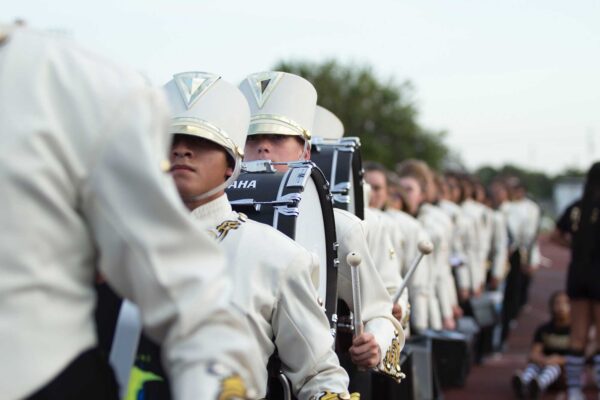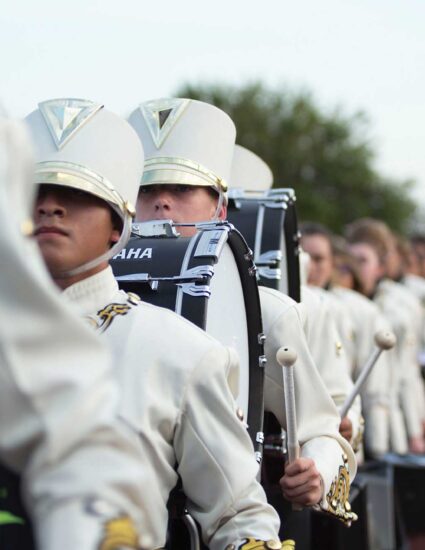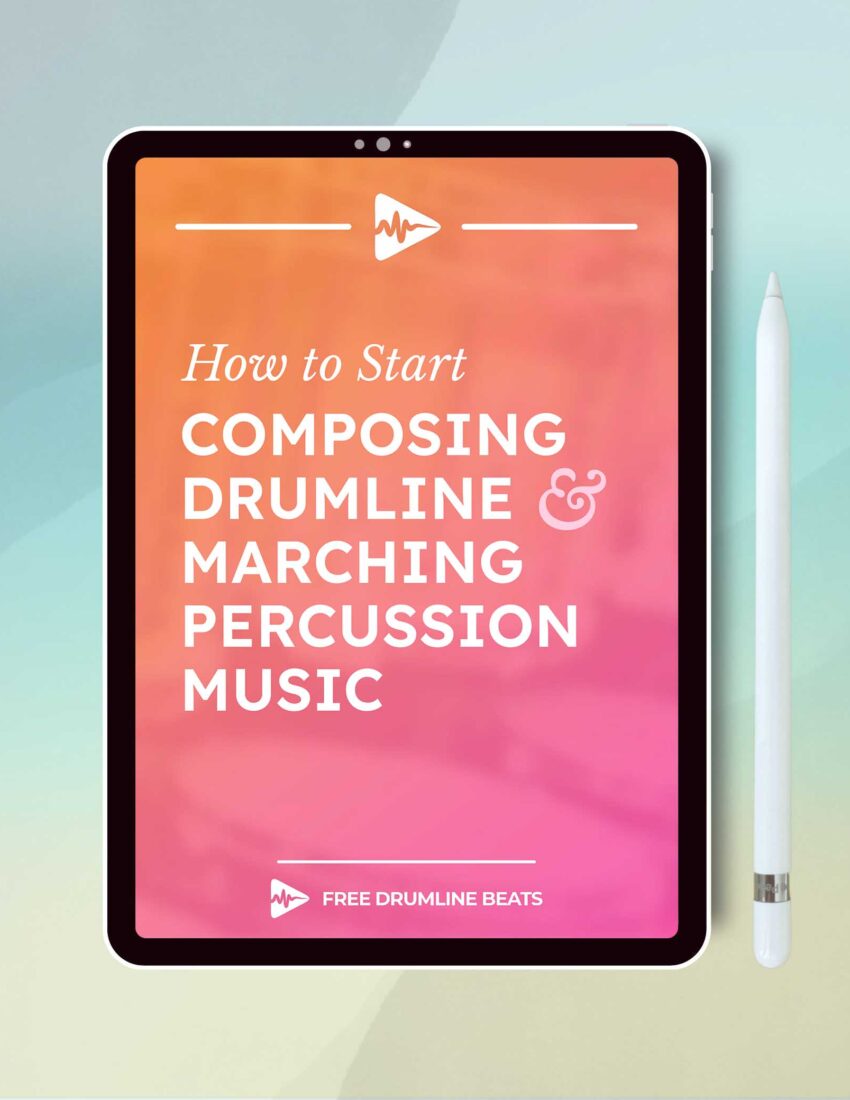Marching Percussion Orchestration Deep-dive Tutorial
Ever dreamed of writing heart-pounding rhythms and powerful cadences for your marching percussion ensemble?
Taking your first steps into composing for this exciting idiom can be daunting.
But, with the right knowledge, you can create music that truly soars—”slaps,” as the kids say.
This article provides fundamental orchestration concepts specifically tailored for the marching percussion environment.
By understanding the unique considerations of marching perc, you’ll be well on your way to crafting impactful and playable arrangements for your ensemble.
Indoor vs. Outdoor Performance Setting
The venue you perform in drastically impacts how your marching percussion parts are heard.
Outdoor stadiums present challenges with acoustics and require a focus on impact and uniformity of sound.
Indoor settings come with their own set of challenges for marching percussion.
High school gyms, the most common indoor performance venue, often have excessive reverb and echo.
This can make intricate details and quiet passages nearly impossible to hear.
Understanding these acoustic limitations will help you tailor your orchestration to punch through the echo and ensure your music remains impactful—no matter where it’s performed.
The acoustics of an indoor space are different from an outdoor venue. Let’s look at how this impacts your orchestration choices.
Marching Percussion Orchestration for Outdoor Venues
We know that percussion is a vital component of the marching band’s overall sound.
But outdoor spaces have their own ‘rules’ we’ll need to follow— not all instruments carry equally well in open air.
Instrument Selection
Instrument selection and smart percussion orchestration can set up your marching percussion ensemble for success.
Outdoor performance requires clarity, power, and impact from your battery and front ensembles.
Let’s look at how.
Prioritize “cutting” timbres
Instruments with high registers and bright tones project well.
This includes instruments like glockenspiels, marimbas (especially higher registers), tuned bells, and even well-placed cymbals (crashes and stacks for accents).
These instruments have higher frequencies that travel farther and cut through ambient noise.
Bass Drum and Low Tenors
While low-end thump adds depth, use it strategically.
Don’t rely solely on bass drums for sustained passages outdoors, as low frequencies can get lost.
Use them for punctuations and accents to create impact.
Snares & Tenors
These are workhorses, but orchestrate their parts for clarity.
Utilize rim techniques and higher pitched rudiments on snares for better cut.
Consider using tenor melodies in higher registers or mallet techniques for clearer articulation outdoors.
Segmental vs. Unison Scoring
Not enough marching percussion arrangers pay attention to how the various marching percussion instruments interact.
So let’s look at segmental scoring vs. unison scoring.
In segmental scoring, different parts play independent rhythmic ideas. In unison scoring, everyone plays the same part (or close to it).
Segmental Playing for Clarity
Break down complex rhythms into smaller, segmented parts played by different parts of the percussion ensemble (toms, marching tenors, bass lines).
This creates a clearer texture compared to full unison playing, which can get muddy outdoors.
Unisons: impacts, not accents.
Use unison hits sparingly for powerful moments where projection is key.
Lots of writers take the same rhythm and essentially triple it:
- Snares play it in unison
- Tenors play it, divided among 4, 5, or 6 pitches
- Bass drums play it, divided among 3-7 pitches
Dividing a cohesive rhythm over tonal instruments like tenors and basses sounds really cool—but it also sounds thick.
Reserve unison for climaxes and “shout sections” to maximize impact.
Otherwise, treat your battery as if it were ONE instrument (I like to think of it as a drum set).
Sometimes you want to hear that instrument play high (snare/upper tenors), sometimes low (basses/lower tenors).
This way, the 3 main battery sections interplay with each other, rather than always duplicating each other.
Layering and Doubling
Layer different percussion sections playing similar rhythmic motifs at different pitches. This strengthens the groove or melody.
For example, double a marimba melody an octave lower on tuned bells for depth and fullness.
Tenors & Basses
This is a classic combo. While the bass drum lays down the low-end foundation, layering a similar rhythmic motif on the marching tenors in a higher octave adds punch and clarity.
This creates a fuller sound that projects better without sacrificing the low-end impact—and it usually sounds pretty funky.
Offsets and Delays
This is a more advanced technique but can be very effective.
Play the same rhythmic motif on two different instruments, but with a slight time delay between them.
This creates a sense of width and depth in the sound, adding interest without sacrificing clarity.
This technique works well with marimbas paired with vibes/bells or snares/high tenors.
Keep it light
Remember, the key to effective layering and doubling is to be smart about it—don’t just double everything! (I made this mistake a lot when I first started writing.)
Choose complementary instruments and motifs that enhance the overall sound without creating muddiness.
Experiment and find what works best for your ensemble, musical selection, and show design.
And your wind writers will appreciate it!

Marching Percussion Orchestration for Indoor Venues
All the same info above regarding outdoor marching perc orchestration still applies in indoor—in fact, it’s probably even more important.
But the art and science of indoor percussion also has some extra layers of complexity.
Frequency overlap, aural non-linearity, and bass masking— this section was wicked fun to write.
Check this out…
Mitigating Indoor Percussion Echo
Specific orchestration techniques that help marching percussion cut through echo in gyms: mallet selection, voicing, & articulation.
This is a long explanation, so here’s the short version first:
TL;DR — play soft most of the time, use almost ZERO bass drum unisons, and go easy on the high-pitch stuff like rim shots.
Ok, here’s the long version.
It’s actually FASCINATING, and it explains a lot about why live music sounds the way it does— good and bad.
High tones “cut.” Low tones travel.
This one is just physics, so thank Einstein, I guess. But the facts are:
High frequencies “cut” through noise better than low frequencies. But lows can travel MUCH farther.
Ok, geek time…
Low Frequencies
Low frequencies have longer wavelengths than high freq’s do, so they diffract more easily around objects.
(They can bend and travel around obstacles like walls or people sitting in a crowded venue.)
This means low tones have more opportunity to reverberate and be heard again (and again, and again..)
High Frequencies
High frequencies, on the other hand, have shorter wavelengths. Thus they tend to travel straighter and are less likely to be bent by minor obstacles.
Therefore, their sound seems to disappear sooner than the low tones.
Human Hearing
Our ears are naturally more sensitive to higher frequencies.
This means that even if a high and low frequency sound have the same intensity (loudness), we will perceive the high frequency as being louder, making it stand out more from background noise.
So, while both frequencies can be masked by noise, the factors mentioned above give high frequencies an advantage in being heard over background noise, making them seem to “cut through” better.
This is why instruments like hi-hats and cymbals can be clearly heard in a loud ensemble even though they may not be the loudest instruments in terms of pure sound energy.
No bass unisons cuz “bass masking”
“Bass masking” is a phenomenon in our hearing where loud low-frequency sounds can make it difficult to hear higher-frequency sounds.
It can happen even if the high-frequency sounds are physically present at the same volume.
This is about to blow your mind (and maybe ear drums)…
Non-Linearity of the Ear
At high volumes, our inner ear behaves a bit like a compressor.
When loud sounds are present, the hair cells in our cochlea that are responsible for hearing can become overloaded.
This can cause them to vibrate excessively, which can interfere with their ability to detect quieter sounds.
Frequency Overlap
Low-frequency sounds, like those from a bass guitar or kick drum, can bleed into our perception of higher frequencies.
This is because the intense low frequencies can create harmonic distortion within the cochlea.
(Harmonics are multiples of the fundamental frequency, and they can fall within the range of higher frequencies we’re trying to hear.)
Masking Threshold
In audio science, a masking threshold refers to a volume level at which a low-frequency sound can start to mask or drown-out a higher-frequency sound.
The exact threshold depends on several factors, including the intensity of the low frequency, the frequency difference between the two sounds, and your hearing sensitivity.
The bass masking effect is particularly noticeable in live music situations and in poorly designed sound systems where the bass frequencies are not properly controlled.
Here’s what that sounds like for us.
Loss of Detail & Clarity
When high frequencies are masked by bass, the overall sound can become muddy and indistinct. Instruments like guitars, cymbals, and vocals can lose their crispness and detail.
Listening Fatigue & Discomfort
The masking effect can make it more difficult for our ears to distinguish between different sounds.
This can lead to listening fatigue and a feeling that the music is harsh or unpleasant.
(…sounds like almost every winter percussion show I’ve ever seen…)
Smaller/indoor has one advantage.
Indoor settings are smaller, and the sound is contained.
So, while things get very boomy very quickly, it’s also true that soft, delicate passages can be heard indoors while they would likely be completely inaudible outdoors.
Use this to your advantage and write some softer passages where appropriate!
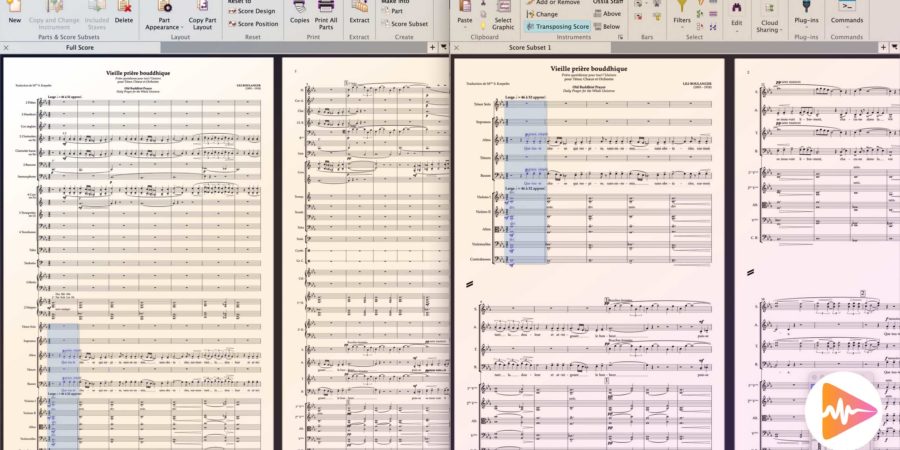
The Phrase Chart – creating a plan
The best advice I ever heard for writing & orchestrating well for marching percussion was this:
Use a phrase chart.
I had never heard of a phrase chart before.
(Are these common in “real” music composition? I didn’t go to music school. Never even taken a music theory class in my life).
I got this advice and the example below from my good friend, inspiration, and long-time percussion mentor, not to mention former instructor:
Thom Hannum, of UMass Drumline and DCI Hall of Fame …fame.
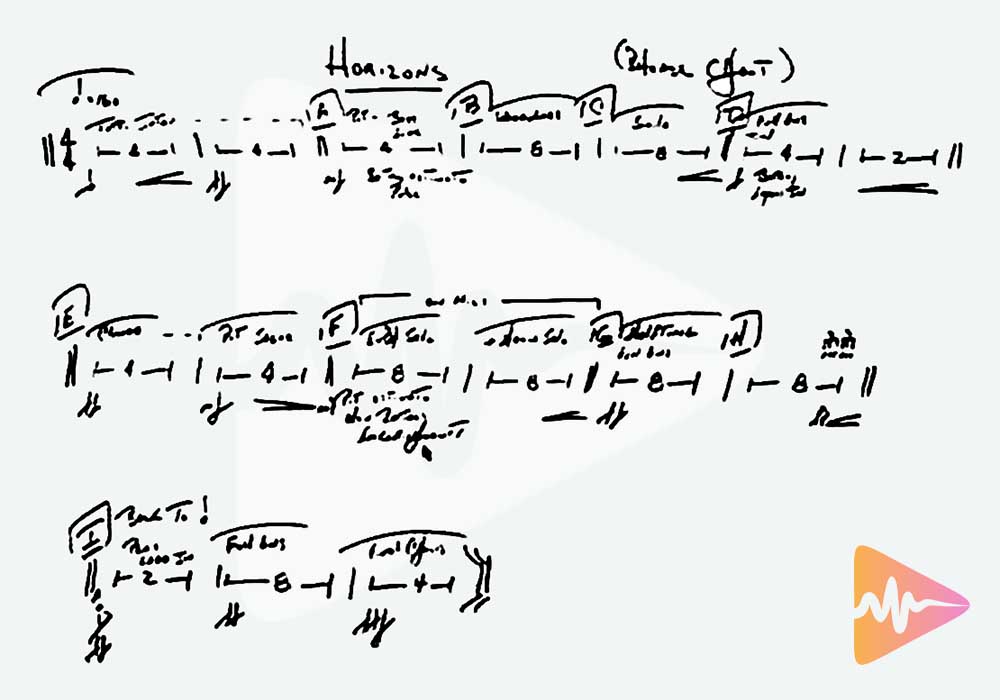
It’s a little hard to read, but here’s how this Phrase Chart works.
What is a Marching Percussion Phrase Chart?
It’s a map of a performance piece. The chart doesn’t need any actual music on it— it’s just a guide to understanding the musical piece.
It lists the phrases in the piece in order, and provides some important information about each phrase.
Once you have the piece mapped out into a phrase chart, you can see how the phrases fit together, and understand how your marching percussion orchestration and arrangement needs to fit into those pieces.
Elements of a Marching Percussion Phrase Chart
- Identify phrases in the winds score
- Define their function
- Tempi, dynamic shape
- Establish the lead voice
Here’s what that means.
Identify phrases in the musical score
Start by reading and listening to the winds score (or Pit score if you’re a winter percussion battery writer).
Every good score has patterns and phrases baked in.
Define their function
Each phrase can be identified as intro, transition, development, build, or climax.
Determine which function each phrase serves, so your writing can match the feel.
Tempi, dynamic shape
It goes without saying, but you need to understand the tempo and dynamic range of each phrase.
Add to that some extra musicality elements like half-time feel or call-and-response motif.
Establish the lead voice
Similar to the pitch range discussion above, the lead voices in each phrase will set the tone (no pun intended) for your writing choices.
You’ll have to decide if you want to match the lead voice, counter it, support it, etc. But to do that, you’ll need to know what it is!
How to use a Marching Percussion Phrase Chart
Once you have these elements identified and written down in your chart, what do you do with them?
Cool chart, but how does it help? — It lets you tie the piece together.
- Connections between phrases
- Length & sequence of phrase
- Support the focal point to create effect
Let’s take a look.
Connections between phrases
If your chart shows that Phrase #3 is 8 bars of build into a 4-bar impact statement, you can’t write 12 bars of the same groove.
Understanding how the phrases fit together forces you to plan ahead, and adjust the direction and pacing of your writing accordingly.
Length & sequence of phrase
If one phrase is 8 bars long and the next is only 4, knowing the length requirements helps define if grooves will repeat or if you need to get in and get out.
Support the focal point to create effect
Knowing exactly which voice needs to be the focus helps determine which percussion voice(s) should support, counter, or double the main voice.
The phrase chart is an invaluable tool for any marching percussion writer.
By taking the time to analyze the existing music and map it out, you can create percussion parts that are not only technically impressive but also emotionally impactful and deeply integrated with the entire musical composition.
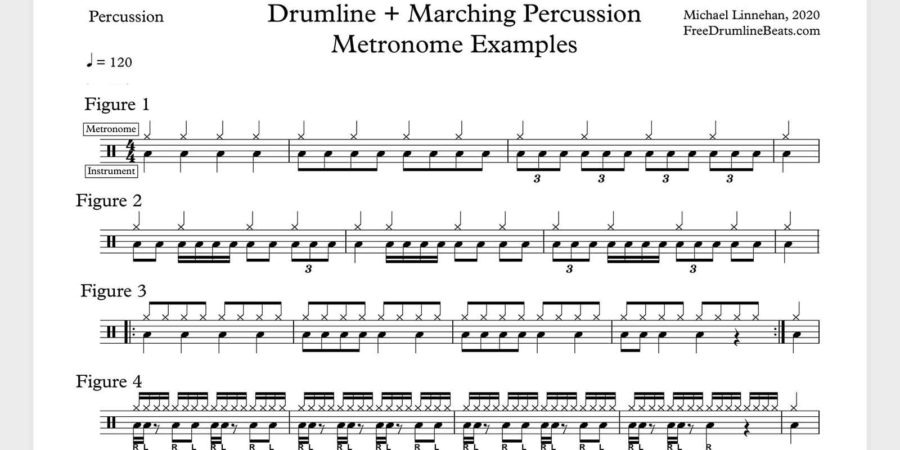
Additional Outdoor Marching Percussion Orchestration Tips
Voicing
When writing melodic lines for mallet instruments (marimbas, bells), prioritize higher registers for better audibility outdoors.
Articulation
Emphasize clean articulations like clear attacks and precise rolls for better projection.
Minimize flam techniques, as their ghost notes can get lost in outdoor spaces.
Dynamics
Dynamic variation can still be impactful.
Utilize sudden drops in volume to create contrast and highlight important moments.
You can also achieve dynamic contrast by switching between instruments with different inherent volumes (e.g., marimba vs. cymbal crash).
Staging & Drill Design
This one is tough but adds A TON of General Effect points: coordinate with your drill designer about defining the musical climax moments.
Moving the percussion line towards the audience or judges’ box during loud passages can add a visual element that reinforces the impact of the music.
Consider incorporating props or auxiliary instruments like claves or tambourines for specific visual and sonic effects.
By focusing on these strategies, marching percussion arrangers can create a powerful and clear sound that translates well in outdoor venues, contributing significantly to the overall impact of the marching band’s performance.
Spacing & Proximity to Other Instruments
Marching percussion needs to be heard clearly amidst the winds and across a large space.
Think about how different instruments project sound.
